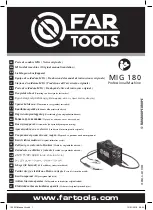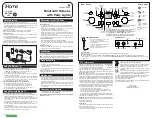
EasyWeld / HandyWeld 160
STICK (MMAW) Welding 6-6 0-5617
6.11 Arc Welding Technique
A Word to Beginners
For those who have not yet done any welding, the
simplest way to commence is to run beads on a piece
of scrap plate. Use mild steel plate about 6.0mm thick
and a 3.2mm electrode. Clean any paint, loose scale or
grease off the plate and set it firmly on the work bench
so that welding can be carried out in the downhand
position. Make sure that the work clamp is making
good electrical contact with the work, either directly
or through the work table. For light gauge material,
always clamp the work lead directly to the job, oth-
erwise a poor circuit will probably result.
6.12 The Welder
Place yourself in a comfortable position before begin-
ning to weld. Get a seat of suitable height and do as
much work as possible sitting down. Don’t hold your
body tense. A taut attitude of mind and a tensed body
will soon make you feel tired. Relax and you will find
that the job becomes much easier. You can add much
to your peace of mind by wearing a leather apron and
gauntlets. You won’t be worrying then about being
burnt or sparks setting alight to your clothes.
Place the work so that the direction of welding is
across, rather than to or from, your body. The elec-
trode holder lead should be clear of any obstruction
so that you can move your arm freely along as the
electrode burns down. If the lead is slung over your
shoulder, it allows greater freedom of movement and
takes a lot of weight off your hand. Be sure the insula-
tion on your cable and electrode holder is not faulty,
otherwise you are risking an electric shock.
6.13 Striking the Arc
Practice this on a piece of scrap plate before going on
to more exacting work. You may at first experience
difficulty due to the tip of the electrode “STICKing” to
the work piece. This is caused by making too heavy
a contact with the work and failing to withdraw the
electrode quickly enough. A low amperage will accen-
tuate it. This freezing-on of the tip may be overcome by
scratching the electrode along the plate surface in the
same way as a match is struck. As soon as the arc is
established, maintain a 1.6mm to 3.2mm gap between
the burning electrode end and the parent metal. Draw
the electrode slowly along as it melts down.
Another difficulty you may meet is the tendency, after
the arc is struck, to withdraw the electrode so far
that the arc is broken again. A little practice will soon
remedy both of these faults.
Art # A-07696_AB
20°
1.6 mm (1/16”)
Figure 6-11: Striking an arc
6.14 Arc Length
The securing of an arc length necessary to produce a
neat weld soon becomes almost automatic. You will
find that a long arc produces more heat. A very long
arc produces a crackling or spluttering noise and the
weld metal comes across in large, irregular blobs.
The weld bead is flattened and spatter increases. A
short arc is essential if a high quality weld is to be
obtained although if it is too short there is the danger
of it being blanketed by slag and the electrode tip being
solidified in. If this should happen, give the electrode
a quick twist back over the weld to detach it. Contact
or “touch-weld” electrodes such as Ferrocraft 21 do
not STICK in this way, and make welding much easier.
6.15 Rate of Travel
After the arc is struck, your next concern is to maintain
it, and this requires moving the electrode tip towards
the molten pool at the same rate as it is melting away.
At the same time, the electrode has to move along the
plate to form a bead. The electrode is directed at the
weld pool at about 20° from the vertical. The rate of
travel has to be adjusted so that a well-formed bead
is produced.
If the travel is too fast, the bead will be narrow and
strung out and may even be broken up into individual
globules. If the travel is too slow, the weld metal piles
up and the bead will be too large.
6.16 Making Welded Joints
Having attained some skill in the handling of an elec-
trode, you will be ready to go on to make up welded
joints.
NOTE!
The welding current range values should be
used as a guide only. Current delivered to the
arc is dependent on the welding arc voltage,
and as welding arc voltage varies between
different classes of electrode, welding current
at any one setting would vary according to the
type of electrode in use. The operator should
use the welding current range values as a guide,
then finally adjust the current setting to suit the
application.
Summary of Contents for Cigweld EasyWeld 160
Page 8: ...This Page Intentionally Blank ...
Page 14: ...EasyWeld HandyWeld 160 GENERAL INFORMATION 1 6 0 5617 This Page Intentionally Blank ...
Page 26: ...EasyWeld HandyWeld 160 INSTALLATION 3 4 0 5617 This Page Intentionally Blank ...
Page 32: ...EasyWeld HandyWeld 160 OPERATION 4 6 0 5617 This Page Intentionally Blank ...
Page 56: ...MIG GMAW WELDING 5 24 Manual 0 5617 EasyWeld HandyWeld 160 This Page Intentionally Blank ...
Page 70: ...EasyWeld HandyWeld 160 STICK MMAW Welding 6 14 0 5617 This Page Intentionally Blank ...
Page 78: ...KEY SPARE PARTS 8 4 0 5617 EasyWeld HandyWeld 160 This Page Intentionally Blank ...
Page 80: ...EasyWeld HandyWeld 160 APPENDIX A 2 0 5617 This Page Intentionally Blank ...
Page 83: ...EasyWeld HandyWeld 160 This Page Intentionally Blank ...
















































